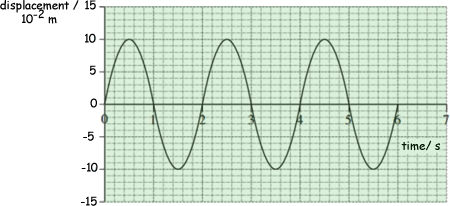Simple Harmonic Motion - Multiple Choice Questions Q11. Which one of the following statements always applies to a damping force acting on a vibrating system?
Q12. Which one of the following statements concerning the acceleration of an object moving with simple harmonic motion is correct?
At the centre of the oscillation x = 0 - when that is the case acceleration is also zero so choice B is untrue and C is true. At the 'extremity' displacement is a maximum and acceleration is also maximum - but in the opposite direction - so D is untrue.
Q13. When the length of a simple pendulum is decreased by 600 mm, the period of oscillation is halved. What was the original length of the pendulum?
T2 = constant x L
T12/L1 = T22/L2 L1= T12L2 /T22 L1 = L L2 = L - 600 T1 = T T2 = 0.5 T L = T2(L - 600)/(0.5 T)2 L = 4(L - 600) 3L = 2400 L = 800 mm (and therefore length of the second was 200 mm) Double check root 800 = 28.28 root 200 = 14.14 (half the value)
Q14. Which one of the following gives the phase difference between the particle velocity and the particle displacement in simple harmonic motion?
One cycle is 2
Q15. A body executes simple harmonic motion. Which one of the graphs, A to D, best shows the relationship between the kinetic energy, Ek, of the body and its distance from the centre of oscillation?
When x = 0 velocity is a maximum - when x = A velocity = zero. Therefore choice C is a non-starter. KE = 1/2 mv2 = 2 KE = a constant value - a constant multiplied by x2
The shape of the graph will therefore be that of choice B
Q16. The displacement (in mm) of the vibrating cone of a large loudspeaker can be represented by the equation x = 10 cos (150t), where t is the time in s. Which line, A to D, in the table gives the amplitude and frequency of the vibrations.
In this case '10' so the amplitude is 10 150 corresponds to 2 so f = 150/2 Choice C
Q17. A mechanical system is oscillating at resonance with a constant amplitude. Which one of the following statements is not correct?
Q18. A particle of mass 0.20 kg moves with simple harmonic motion of amplitude 2.0 × 10–2m. If the total energy of the particle is 4.0 × 10–5J, what is the time period of the motion?
Total energy = max kinetic energy = 1/2 mv
vmax = ωA = 2πfA (
Q19. The graph shows the variation in displacement with time for an object moving with simple harmonic motion.
Q20. Two pendulums, P and Q, are set up alongside each other. The period of P is 1.90 s and the period of Q is 1.95 s. How many oscillations are made by pendulum Q between two consecutive instants when P and Q move in phase with each other?
The difference in time period is 0.05s - therefore to make up a complete extra swing P will move one more period than Q does in the same time. Let number of swings of Q = n Then n x 1.95 = (n+1) x 1.90 1.95n = 1.90n + 1.90 0.05n = 1.90 n = 38 - choice B |
Follow me...
|










